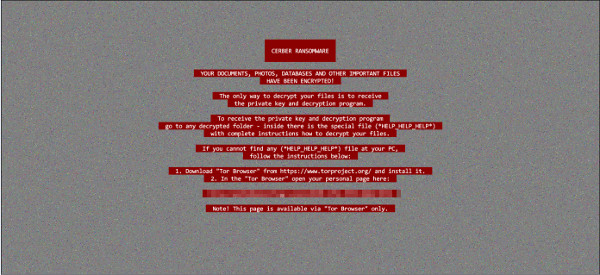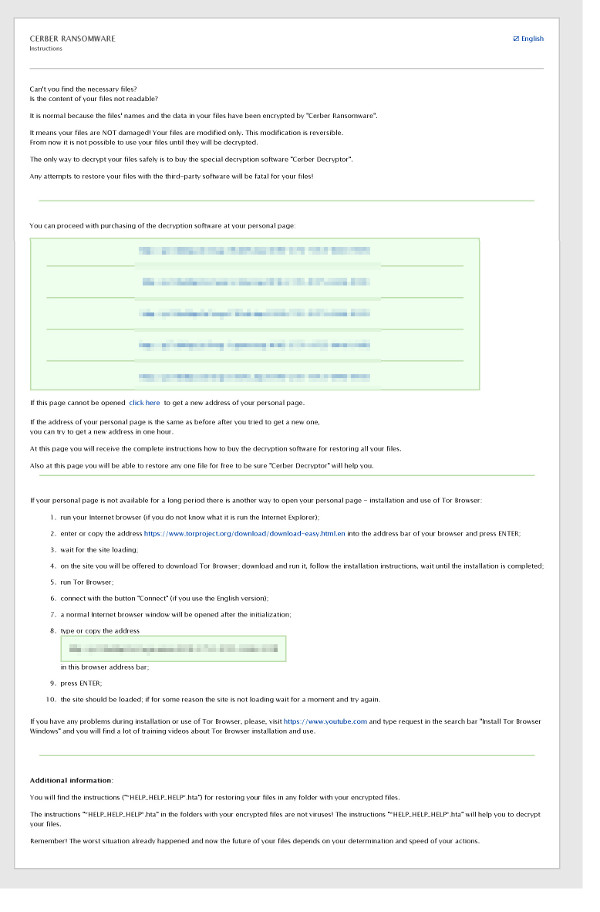RANSOM_CERBER.F117AK
Ransom:Win32/Cerber(Microsoft);Troj.Ransom.W32.Zerber!c(AegisLab)
Windows


Threat Type: Trojan
Destructiveness: No
Encrypted: Yes
In the wild: Yes
OVERVIEW
This Trojan arrives on a system as a file dropped by other malware or as a file downloaded unknowingly by users when visiting malicious sites.
It connects to certain websites to send and receive information. It terminates itself if it detects it is being run in a virtual environment. It deletes the initially executed copy of itself.
TECHNICAL DETAILS
Arrival Details
This Trojan arrives on a system as a file dropped by other malware or as a file downloaded unknowingly by users when visiting malicious sites.
Installation
This Trojan drops the following files:
- %Desktop%\_HELP_HELP_HELP_{random}.jpg - ransom note
- %Desktop%\_HELP_HELP_HELP_{random}.hta - ransom note
- %User Temp%\{random name}.bmp - background image
- {folders containing encrypted files}\_HELP_HELP_HELP_{random}.hta - ransom note
- {folders containing encrypted files}\_HELP_HELP_HELP_{random}.jpg - ransom note
(Note: %Desktop% is the desktop folder, where it usually is C:\Documents and Settings\{user name}\Desktop in Windows 2000, Windows Server 2003, and Windows XP (32- and 64-bit); C:\Users\{user name}\Desktop in Windows Vista (32- and 64-bit), Windows 7 (32- and 64-bit), Windows 8 (32- and 64-bit), Windows 8.1 (32- and 64-bit), Windows Server 2008, and Windows Server 2012.. %User Temp% is the user's temporary folder, where it usually is C:\Documents and Settings\{user name}\Local Settings\Temp on Windows 2000, Windows Server 2003, and Windows XP (32- and 64-bit); C:\Users\{user name}\AppData\Local\Temp on Windows Vista (32- and 64-bit), Windows 7 (32- and 64-bit), Windows 8 (32- and 64-bit), Windows 8.1 (32- and 64-bit), Windows Server 2008, and Windows Server 2012.)
Other System Modifications
This Trojan adds the following registry entries as part of its installation routine:
HKEY_CURRENT_USER\Control Panel\Desktop
Wallpaper = %User Temp%\{random filename}.bmp
Process Termination
This Trojan terminates the following processes if found running in the affected system's memory:
- agntsvc.exeagntsvc.exe
- agntsvc.exeencsvc.exe
- agntsvc.exeisqlplussvc.exe
- dbeng50.exe
- dbsnmp.exe
- firefoxconfig.exe
- msftesql.exe
- mydesktopqos.exe
- mydesktopservice.exe
- mysqld-nt.exe
- mysqld-opt.exe
- mysqld.exe
- ocautoupds.exe
- ocomm.exe
- ocssd.exe
- oracle.exe
- sqbcoreservice.exe
- sqlagent.exe
- sqlbrowser.exe
- sqlservr.exe
- sqlwriter.exe
- synctime.exe
- tbirdconfig.exe
- xfssvccon.exe
- fbsever.exe
Other Details
This Trojan connects to the following website to send and receive information:
- Uses the following IP range via port 6892:
- {BLOCKED}.{BLOCKED}xx2.1.0/27
- {BLOCKED}.{BLOCKED}xx3.1.0/27
- {BLOCKED}.{BLOCKED}239.24.0/23
It encrypts files with the following extensions:
- .123
- .1cd
- .3dm
- .3ds
- .3fr
- .3g2
- .3gp
- .3pr
- .602
- .7z
- .7zip
- .aac
- .ab4
- .abd
- .acc
- .accdb
- .accde
- .accdr
- .accdt
- .ach
- .acr
- .act
- .adb
- .adp
- .ads
- .aes
- .agdl
- .ai
- .aiff
- .ait
- .al
- .aoi
- .apj
- .apk
- .arc
- .arw
- .ascx
- .asf
- .asm
- .asp
- .aspx
- .asset
- .asx
- .atb
- .avi
- .awg
- .back
- .backup
- .backupdb
- .bak
- .bank
- .bat
- .bay
- .bdb
- .bgt
- .bik
- .bin
- .bkp
- .blend
- .bmp
- .bpw
- .brd
- .bsa
- .bz2
- .c
- .cash
- .cdb
- .cdf
- .cdr
- .cdr3
- .cdr4
- .cdr5
- .cdr6
- .cdrw
- .cdx
- .ce1
- .ce2
- .cer
- .cfg
- .cfn
- .cgm
- .cib
- .class
- .cls
- .cmd
- .cmt
- .config
- .contact
- .cpi
- .cpp
- .cr2
- .craw
- .crt
- .crw
- .cry
- .cs
- .csh
- .csl
- .csr
- .css
- .csv
- .d3dbsp
- .dac
- .das
- .dat
- .db
- .db3
- .db_journal
- .dbf
- .dbx
- .dc2
- .dch
- .dcr
- .dcs
- .ddd
- .ddoc
- .ddrw
- .dds
- .def
- .der
- .des
- .design
- .dgc
- .dgn
- .dif
- .dip
- .dit
- .djv
- .djvu
- .dng
- .doc
- .docb
- .docm
- .docx
- .dot
- .dotm
- .dotx
- .drf
- .drw
- .dtd
- .dwg
- .dxb
- .dxf
- .dxg
- .edb
- .eml
- .eps
- .erbsql
- .erf
- .exf
- .fdb
- .ffd
- .fff
- .fh
- .fhd
- .fla
- .flac
- .flb
- .flf
- .flv
- .forge
- .fpx
- .frm
- .fxg
- .gbr
- .gho
- .gif
- .gpg
- .gray
- .grey
- .groups
- .gry
- .gz
- .h
- .hbk
- .hdd
- .hpp
- .html
- .hwp
- .ibank
- .ibd
- .ibz
- .idx
- .iif
- .iiq
- .incpas
- .indd
- .info
- .info_
- .iwi
- .jar
- .java
- .jnt
- .jpe
- .jpeg
- .jpg
- .js
- .json
- .k2p
- .kc2
- .kdbx
- .kdc
- .key
- .kpdx
- .kwm
- .laccdb
- .lay
- .lay6
- .lbf
- .lck
- .ldf
- .lit
- .litemod
- .litesql
- .lock
- .ltx
- .lua
- .m
- .m2ts
- .m3u
- .m4a
- .m4p
- .m4u
- .m4v
- .ma
- .mab
- .mapimail
- .max
- .mbx
- .md
- .mdb
- .mdc
- .mdf
- .mef
- .mfw
- .mid
- .mkv
- .mlb
- .mml
- .mmw
- .mny
- .money
- .moneywell
- .mos
- .mov
- .mp3
- .mp4
- .mpeg
- .mpg
- .mrw
- .ms11
- .msf
- .msg
- .mts
- .myd
- .myi
- .nd
- .ndd
- .ndf
- .nef
- .nk2
- .nop
- .nrw
- .ns2
- .ns3
- .ns4
- .nsd
- .nsf
- .nsg
- .nsh
- .nvram
- .nwb
- .nx2
- .nxl
- .nyf
- .oab
- .obj
- .odb
- .odc
- .odf
- .odg
- .odm
- .odp
- .ods
- .odt
- .ogg
- .oil
- .omg
- .one
- .onenotec2
- .orf
- .ost
- .otg
- .oth
- .otp
- .ots
- .ott
- .p12
- .p7b
- .p7c
- .pab
- .pages
- .paq
- .pas
- .pat
- .pbf
- .pcd
- .pct
- .pdb
- .pdd
- .pef
- .pem
- .pfx
- .php
- .pif
- .pl
- .plc
- .plus_muhd
- .pm
- .pm!
- .pmi
- .pmj
- .pml
- .pmm
- .pmo
- .pmr
- .pnc
- .pnd
- .png
- .pnx
- .pot
- .potm
- .potx
- .ppam
- .pps
- .ppsm
- .ppsx
- .ppt
- .pptm
- .pptx
- .prf
- .private
- .ps
- .psafe3
- .psd
- .pspimage
- .pst
- .ptx
- .pub
- .pwm
- .py
- .qba
- .qbb
- .qbm
- .qbr
- .qbw
- .qbx
- .qby
- .qcow
- .qcow2
- .qed
- .qtb
- .r3d
- .raf
- .rar
- .rat
- .raw
- .rb
- .rdb
- .re4
- .rm
- .rtf
- .rvt
- .rw2
- .rwl
- .rwz
- .s3db
- .safe
- .sas7bdat
- .sav
- .save
- .say
- .sch
- .sd0
- .sda
- .sdb
- .sdf
- .secret
- .sh
- .sldm
- .sldx
- .slk
- .slm
- .sql
- .sqlite
- .sqlite-shm
- .sqlite-wal
- .sqlite3
- .sqlitedb
- .sr2
- .srb
- .srf
- .srs
- .srt
- .srw
- .st4
- .st5
- .st6
- .st7
- .st8
- .stc
- .std
- .sti
- .stl
- .stm
- .stw
- .stx
- .svg
- .swf
- .sxc
- .sxd
- .sxg
- .sxi
- .sxm
- .sxw
- .tar
- .tax
- .tbb
- .tbk
- .tbn
- .tex
- .tga
- .tgz
- .thm
- .tif
- .tiff
- .tlg
- .tlx
- .txt
- .uop
- .uot
- .upk
- .usr
- .vb
- .vbox
- .vbs
- .vdi
- .vhd
- .vhdx
- .vmdk
- .vmsd
- .vmx
- .vmxf
- .vob
- .vpd
- .vsd
- .wab
- .wad
- .wallet
- .war
- .wav
- .wb2
- .wk1
- .wks
- .wma
- .wmf
- .wmv
- .wpd
- .wps
- .x11
- .x3f
- .xis
- .xla
- .xlam
- .xlc
- .xlk
- .xlm
- .xlr
- .xls
- .xlsb
- .xlsm
- .xlsx
- .xlt
- .xltm
- .xltx
- .xlw
- .xml
- .xps
- .xxx
- .ycbcra
- .yuv
- .zip
It renames encrypted files using the following names:
- {10 Random Characters}.{4 Random}
It terminates itself if it detects it is being run in a virtual environment.
It does the following:
- It checks for the path of installed AntiVirus, Firewall and AntiSpyware products then avoid encrypting files under those directories
- It terminates itself if found running in any of the following countries:
- Armenia
- Azerbaijan
- Belarus
- Georgia
- Kyrgyzstan
- Kazakhstan
- Moldova
- Russia
- Turkmenistan
- Tajikistan
- Ukraine
- Uzbekistan
- It avoids encrypting the following files:
- bootsect.bak
- iconcache.db
- ntuser.dat
- thumbs.db
- It avoids encrypting files in the following paths:
- :\\$getcurrent\\
- :\\$recycle.bin\\
- :\\$windows.~bt\\
- :\\$windows.~ws\\
- :\\boot\\
- :\\documents and settings\\all users\\
- :\\documents and settings\\default user\\
- :\\documents and settings\\localservice\\
- :\\documents and settings\\networkservice\\
- :\\intel\\
- :\\msocache\\
- :\\perflogs\\
- :\\program files (x86)\\
- :\\program files\\
- :\\programdata\\
- :\\recovery\\
- :\\recycled\\
- :\\recycler\\
- :\\systemvolume information\\
- :\\temp\\
- :\\windows.old\\
- :\\windows10upgrade\\
- :\\windows\\
- :\\winnt\\
- \\appdata\\local\\
- \\appdata\\locallow\\
- \\appdata\\roaming\\
- \\local settings\\
- \\public\\music\\sample music\\
- \\public\\pictures\\samplepictures\\
- \\public\\videos\\sample videos\\
- \\tor browser\\
- It speaks the following text using text-to-speech application:
- "Attention! Attention! Attention! Your documents, photos, databases and other important files have been encrypted!"
- It is configured to target related files under the following folders:
- \\bitcoin\\
- \\excel\\
- \\microsoft sql server\\
- \\microsoft\\excel\\
- \\microsoft\\microsoftsql server\\
- \\microsoft\\office\\
- \\microsoft\\onenote\\
- \\microsoft\\outlook\\
- \\microsoft\\powerpoint\\
- \\microsoft\\word\\
- \\office\\
- \onenote\
- \outlook\
- \powerpoint\
- \steam\
- \the bat!\
- \thunderbird\
- \word\
It deletes the initially executed copy of itself
NOTES:
The malware changes the affected system wallpaper to the following image:

The _HELP_HELP_HELP_{random}.hta contains the following information:

SOLUTION
Step 1
Before doing any scans, Windows XP, Windows Vista, and Windows 7 users must disable System Restore to allow full scanning of their computers.
Step 2
Note that not all files, folders, and registry keys and entries are installed on your computer during this malware's/spyware's/grayware's execution. This may be due to incomplete installation or other operating system conditions. If you do not find the same files/folders/registry information, please proceed to the next step.
Step 3
Restart in Safe Mode
Step 4
Search and delete these files
- %Desktop%\_HELP_HELP_HELP_{random}.jpg
- %Desktop%\_HELP_HELP_HELP_{random}.hta
- %User Temp%\{random name}.bmp
- {folders containing encrypted files}\_HELP_HELP_HELP_{random}.hta
- {folders containing encrypted files}\_HELP_HELP_HELP_{random}.jpg
Step 5
Restart in normal mode and scan your computer with your Trend Micro product for files detected as RANSOM_CERBER.F117AK. If the detected files have already been cleaned, deleted, or quarantined by your Trend Micro product, no further step is required. You may opt to simply delete the quarantined files. Please check this Knowledge Base page for more information.
Step 6
Reset your Desktop properties
Step 7
Restore encrypted files from backup.
Did this description help? Tell us how we did.


